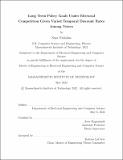Long Term Policy Goals Under Electoral Competition Given Varied Temporal Discount Rates Among Voters
Author(s)
Nicholas, Sara
DownloadThesis PDF (1.126Mb)
Advisor
Magazinnik, Asya
Terms of use
Metadata
Show full item recordAbstract
Many important issues facing the world involve temporal tradeoffs, requiring costly investment in the short term for payoffs that accrue much later. However, politicians facing frequent elections are held accountable to voter preferences, where voters tend to be myopic, making investment difficult. Further, the costs and benefits of an investment are often distributed unevenly across voters. Thus investments take a two dimensional shape, creating both cross-sectional and inter-temporal distributions of utility. This paper examines under what conditions investment can occur, and studies how different levels and types of investments distribute utility. We develop a model involving multiple voting districts with variable time preferences and model a game involving legislative action followed by an election, solving the game via backward induction to find the subgame perfect Nash equilibria.
Date issued
2022-05Department
Massachusetts Institute of Technology. Department of Electrical Engineering and Computer SciencePublisher
Massachusetts Institute of Technology